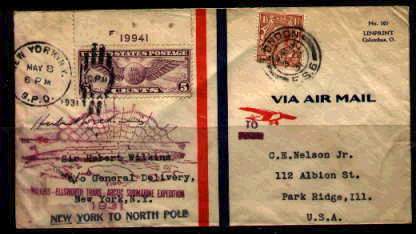Covers from the
1931 Wilkins-Ellsworth
Trans-Arctic Submarine Expedition
This was a well-publicized, yet ill-fated expedition of which the philatelic proceeds played a major role in getting the submarine out to sea. Wilkins had purchased a U.S. Navy surplus submarine, the O-12, and fitted it out for arctic conditions. The airplane had replaced old forms of travel, but Wilkins was determined to make a transpolar crossing in another form. Wilkins had hoped to cross the Arctic Ocean in his submarine, the Nautilus. The "Ellsworth" portion of the expedition referred to American millionaire and explorer Lincoln Ellsworth, who was to achieve separate fame a few years later, by making the first flight across the Antarctic continent. Wilkins, who had already executed some previous philatelic documentations of his events, used the additional proceeds from philatelic covers being serviced for a fee, to help finance the venture itself; philatelists sent specially formatted envelopes to Wilkins for servicing on this historic mission.
Apparently, to save space onboard an already cramped submarine, he had the collectors place their own address in the section that normally would have been used to put his address when sending the un-serviced cover to him. Wilkins then used small "to" and "from" rubber stamps, along with some "killer" plugs, to cover over the original intent; then added a stamp or stamps for whichever route the collector had asked for (routes available for documentation included New York to London, New York to North Pole, New York to Spitsbergen, New York to Bergen, etc.-often you will see these routes written in pencil or ink by the original sender) and applied the appropriate foreign stamp(s) when mailing the original envelope back to the collector, thus resulting in the dual-franking that is so commonly seen here. All covers which have been registered (sent by registered mail, and appropriate label and markings for that service applied) in the country of its sending are more valuable to polar collectors, inasmuch as less registered mail was tendered for delivery by Wilkins.

Typical New York to North Pole Routing
The above cover, from my collection, is almost singular in the fact that the standard violet cachet has not been applied over the top of anything. The manner in which the sender wrote his name resulted in a perfect application of the expedition cachet, and this is seldom if ever seen on covers that went to collectors who used the mail-in approach. My thought is that this gentleman might have given this cover to Wilkins in person, as there is no indication he mailed the cover to Wilkins. Covers which Wilkins sent back to himself for souvenirs also usually have a clean application of the cachet as opposed to having been applied over the top of the Wilkins address.

